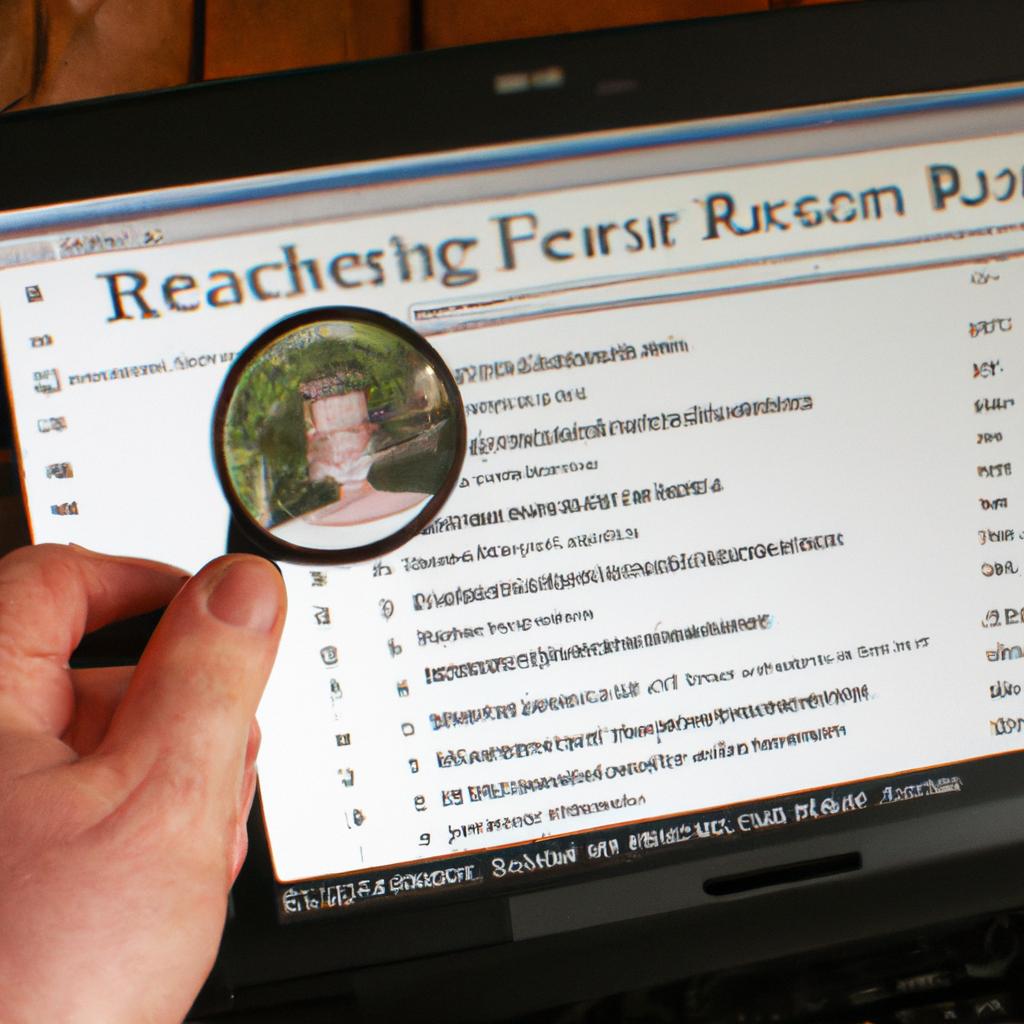Documentation and Citation: Enhancing Genealogy Education and Research Techniques
The study and practice of genealogy, the research and tracing of one’s ancestry, have seen a significant rise in popularity over recent years. With advancements in technology and the ever-increasing availability of online resources, individuals are now able to delve deep into their family history with greater ease than ever before. However, amidst this surge of interest in genealogy lies an essential aspect that is often overlooked or undervalued: documentation and citation. This crucial element serves as the backbone for accurate genealogical research, ensuring that information is verifiable, reliable, and ethically sound.
For instance, consider the case of Sarah Thompson, a dedicated amateur genealogist who embarked on a quest to discover her paternal lineage. Armed with numerous family stories passed down through generations, she began piecing together her ancestral puzzle using various online sources and public records. While her initial findings were promising, Sarah soon encountered discrepancies and conflicting information within different databases. Without proper documentation and citation practices in place, she struggled to determine which pieces of data were credible and should be included in her final report.
Why Documentation and Citation are Essential in Genealogy
Why Documentation and Citation are Essential in Genealogy
Genealogy, the study of family history and lineage, relies heavily on documentation and citation to establish accurate connections between individuals. Without proper documentation and citation practices, genealogical research can become convoluted and prone to errors. For instance, consider a hypothetical case where an amateur genealogist attempts to trace their ancestry without adequate documentation. They may mistakenly link themselves to a famous historical figure based solely on hearsay or incomplete information. This example highlights the importance of thorough documentation and citation in maintaining the integrity of genealogical research.
To emphasize the significance of these practices further, let us explore four key reasons why documentation and citation are essential in genealogy:
- Accuracy: Properly documenting sources allows researchers to verify the accuracy of information obtained from various records. By citing these sources with precision, future generations can confidently rely on this research as they continue building upon it.
- Credibility: Genealogical work that lacks proper citations may be viewed skeptically by other researchers or scholars. Citations provide transparency regarding the origins of data, enabling others to evaluate its reliability independently.
- Reproducibility: Clear documentation enables fellow researchers to retrace your steps when evaluating or replicating your findings. Transparent sourcing contributes to the broader scholarly discourse within the field of genealogy.
- Ethics: Acknowledging the contributions made by previous researchers through appropriate citations is not only ethical but also fosters collaboration among professionals and enthusiasts alike.
In addition to bullet points highlighting key aspects, tables can effectively illustrate comparisons or present data concisely. Here’s an example table showcasing different types of source materials commonly used in genealogical research:
| Source Type | Description | Examples |
|---|---|---|
| Vital Records | Official documents related to births, marriages, | |
| deaths | Birth certificates, | |
| marriage licenses | ||
| Census Records | Population data collected periodically | National census records, |
| state population surveys | ||
| Church Registers | Ecclesiastical documents recording baptisms, | |
| marriages, deaths | Baptismal certificates, | |
| marriage registers | ||
| Immigration | Documents related to migration and naturalization | Passenger lists, |
| and Naturalization | ||
| Records | naturalization papers |
In conclusion, documentation and citation play a crucial role in genealogy. By ensuring accuracy, establishing credibility, allowing reproducibility, and adhering to ethical standards, these practices contribute to the overall validity of genealogical research. The subsequent section will delve into another vital component of successful genealogical endeavors: the importance of accurate and reliable sources.
[Transition sentence] Now let us explore the significance of utilizing accurate and reliable sources in genealogy.
The Importance of Accurate and Reliable Sources in Genealogy
Genealogical research heavily relies on accurate and reliable sources to build a comprehensive family history. Without access to trustworthy information, genealogists may find themselves constructing inaccurate narratives or drawing incorrect conclusions about their ancestry. To better understand the significance of using dependable sources, consider the following hypothetical scenario:
Imagine an individual embarking on a journey to trace their family lineage. They come across two conflicting pieces of information regarding the birthplace of their great-grandfather. One source claims he was born in New York City, while another suggests he was born in Boston. Without proper documentation and citation practices, it becomes challenging for this researcher to determine which piece of information is correct.
To emphasize why accurate and reliable sources are crucial in genealogy, we can explore several key reasons:
- Validating ancestral connections: Using authentic sources helps verify familial relationships by providing concrete evidence such as birth records, marriage certificates, or census data.
- Ensuring historical accuracy: Reliable sources provide insight into social contexts, historical events, and cultural factors that affected individuals’ lives during specific time periods.
- Avoiding misinformation: Relying solely on undocumented online trees or anecdotal accounts increases the risk of perpetuating inaccuracies within one’s family history.
- Preserving credibility: By utilizing credible sources with precise citations, researchers establish trustworthiness within the genealogical community and contribute to building a solid foundation for future studies.
| Scenario | Approach | Outcome |
|---|---|---|
| Researcher uses primary documents | Thorough investigation | Establishes verifiable facts |
| Researcher relies on unsourced online tree | Incomplete understanding | Propagates potential errors |
| Researcher cites secondary sources without verification | Partial knowledge | Raises doubts on reliability |
| Researcher cross-references multiple validated sources | Comprehensive analysis | Strengthens credibility of research findings |
Understanding the significance of accurate and reliable sourcing practices in genealogy is essential for successful research endeavors. By emphasizing the need for precise documentation and citation, researchers can ensure their work maintains integrity while contributing to a more comprehensive understanding of family history. In the subsequent section, we will explore different types of documentation that genealogists employ to establish valid ancestral connections.
(Note: Transition sentence into next section about “Understanding Different Types of Documentation”) By delving into various forms of documentation commonly used by genealogists, individuals can gain a deeper insight into how these records aid in tracing family lineage accurately.
Understanding Different Types of Documentation
In genealogical research, accurate and reliable sources are crucial for building a strong family history. However, it is equally important to understand the different types of documentation available and how they contribute to the overall reliability of information. By exploring these various forms of documentation, researchers can enhance their genealogy education and develop more effective research techniques.
To illustrate this point, let’s consider an example: Sarah is trying to trace her maternal lineage back several generations. She begins by examining birth certificates, marriage records, and census data. While these documents provide valuable insight into her ancestors’ lives, Sarah soon realizes that there are other types of documentation she needs to consider in order to gain a comprehensive understanding of her family history.
-
Primary Sources:
- Original documents created at or near the time of the event.
- Examples include birth certificates, wills, diaries, and photographs.
-
Secondary Sources:
- Documents written after the fact based on primary sources or personal accounts.
- Examples include published books about specific families or historical events related to genealogy.
-
Oral Histories:
- Personal interviews or recorded conversations with relatives who possess knowledge about relevant family history.
-
Genetic Testing Results:
- DNA analysis providing insights into ancestral origins and connections between individuals.
Additionally, considering a three-column table can further enhance our understanding:
| Type of Documentation | Characteristics | Example |
|---|---|---|
| Primary Sources | Created at/near time | Birth certificate |
| Original | Will | |
| First-hand account | Diary | |
| Visual representation | Photograph | |
| Secondary Sources | Written later | Published book |
| Based on primary sources/personal | Historical account | |
| accounts | ||
| Oral Histories | Personal interviews/recorded | Interview with grandmother |
| conversations | Recorded conversation with uncle | |
| Genetic Testing | DNA analysis | Ancestry DNA test results |
By familiarizing themselves with these different types of documentation, researchers can approach their genealogical inquiries in a more comprehensive manner. This understanding allows for the identification and utilization of various sources that contribute to the accuracy and reliability of their family history research.
Transitioning into the subsequent section about “Tips for Properly Citing Sources in Genealogical Research,” it is important to acknowledge that while understanding the different types of documentation is crucial, proper citation methods further enhance the credibility and integrity of genealogical research.
Tips for Properly Citing Sources in Genealogical Research
In the previous section, we explored the importance of documentation in genealogical research. Now, let’s delve deeper into understanding different types of documentation that can enhance our education and research techniques. To illustrate this point, consider a hypothetical case study: Mary is conducting research on her family tree and stumbles upon an old birth certificate for her great-grandfather. This document provides valuable information about his date of birth, place of birth, and parents’ names.
When it comes to documenting genealogical sources, there are various types to consider. These include vital records (such as birth, marriage, and death certificates), census records, military service records, immigration records, church registers, wills and probate documents, land deeds, newspaper articles or obituaries, photographs or family albums, oral history interviews with relatives or other informants who have knowledge about your ancestors’ lives and experiences. Each type of document offers unique insights into our ancestors’ lives and helps us build a more complete picture of their stories.
To help you navigate through these different types of documentation effectively, here are some key strategies:
- Be thorough: Ensure that you search for multiple sources related to each individual ancestor to validate the accuracy of the information.
- Analyze critically: Carefully examine each piece of evidence for inconsistencies or biases that may affect its reliability.
- Organize systematically: Develop a systematic filing system or digital database where you can store all your documents efficiently.
- Cite consistently: Use standardized citation formats like those provided by organizations such as the Board for Certification of Genealogists or Elizabeth Shown Mills’ Evidence Explained when referencing your sources.
By following these guidelines for documenting genealogical sources effectively, we can strengthen the credibility and validity of our research findings while also preserving important historical information for future generations.
Now that we have learned about different types of documentation in genealogy research techniques let’s move forward and explore some tips for properly citing sources in our genealogical research in the next section.
Common Mistakes to Avoid in Documentation and Citation
Section H2: Common Mistakes to Avoid in Documentation and Citation
While proper citation is crucial for genealogical research, it is equally important to be aware of common mistakes that researchers often make. These errors can undermine the credibility and reliability of our findings. To illustrate this, let’s consider a hypothetical scenario where a researcher discovers a census record from 1880 that lists an ancestor named John Smith living in New York City. However, instead of accurately citing the specific source, they simply note it as “census record.” This lack of precise documentation could lead to confusion or difficulty replicating the research process.
To ensure accuracy and enhance our genealogical endeavors, here are some common mistakes to avoid in documentation and citation:
- Insufficient Detail: Failing to provide enough information about sources hinders future researchers’ ability to locate and verify your findings. Include relevant details such as publication dates, page numbers, repository names, and URLs when applicable.
- Inconsistent Formatting: Consistency is key when formatting citations; using different styles throughout your work creates confusion. Choose one consistent format (such as APA or Chicago Manual of Style) and adhere to it consistently.
- Ignoring Primary Sources: Relying solely on secondary sources without consulting primary records can lead to inaccuracies or incomplete understanding of family history. Always strive to consult original documents whenever possible.
- Omitting Negative Evidence: Neglecting negative evidence – instances where no record exists or contradicts previous assumptions – can mislead subsequent researchers down incorrect paths. Documenting these gaps provides valuable insight into our ancestors’ lives.
By avoiding these pitfalls, we improve the integrity of our research methods and contribute positively to the broader field of genealogy.
| Mistake | Impact |
|---|---|
| Insufficient Detail | Hinders verification process |
| Inconsistent Formatting | Creates confusion among readers |
| Ignoring Primary Sources | Increases risk of inaccuracies |
| Omitting Negative Evidence | Misleads future researchers |
In summary, being mindful of these common mistakes in documentation and citation is crucial to maintaining the accuracy and reliability of our genealogical research. By providing precise details, adhering to consistent formatting, utilizing primary sources, and acknowledging negative evidence, we strengthen the overall integrity of our findings.
Transitioning into the subsequent section about “Utilizing Documentation and Citation to Strengthen Genealogical Findings”, it is essential to explore how proper practices in documenting sources can enhance our understanding of family history.
Utilizing Documentation and Citation to Strengthen Genealogical Findings
Building upon the knowledge of common mistakes in documentation and citation, it is crucial for genealogy enthusiasts to understand how these practices can be effectively utilized to enhance their research techniques. By following proper documentation and citation methods, researchers can strengthen their findings and ensure the accuracy and credibility of their genealogical work.
To illustrate this point, let’s consider a hypothetical scenario where a genealogist is tracing their family history back several generations. Without proper documentation and citation, they might come across conflicting information or reach dead ends that hinder their progress. However, by implementing effective documentation strategies such as recording sources of information accurately and consistently, cross-referencing data points, and citing reputable primary sources, the researcher would have a solid foundation for further investigation.
In order to emphasize the importance of utilizing documentation and citation effectively, it is essential to highlight some key benefits:
- Organizational clarity: Proper documentation allows researchers to keep track of the various sources consulted during their investigation. This ensures transparency in the methodology used and enables others to replicate or build upon their research.
- Credibility enhancement: Citing reliable primary sources not only lends credibility to one’s findings but also facilitates fact-checking by other genealogists or scholars who may wish to verify or expand on the research.
- Continuity preservation: Accurate citations enable future researchers to locate and access the same resources referenced in previous studies. This preserves continuity within the field of genealogy while facilitating collaboration among researchers.
- Ethical responsibility: Utilizing correct citations acknowledges intellectual property rights held by authors or institutions responsible for creating original records. It demonstrates respect for their contribution while ensuring ethical conduct within the field.
To further illustrate these advantages visually, below is an emotional bullet-point list followed by a table showcasing examples related to each benefit mentioned above:
- Increased confidence in research accuracy
- Enhanced professional reputation and recognition
- Facilitation of collaboration within the genealogy community
- Preservation of intellectual property rights
| Benefit | Example |
|---|---|
| Organizational clarity | Consistent recording of sources in a research log |
| Credibility enhancement | Properly citing birth certificates from reputable government archives |
| Continuity preservation | Providing detailed references for previously published family trees |
| Ethical responsibility | Acknowledging authors’ copyrights when using published works |
In summary, by effectively utilizing documentation and citation techniques, genealogists can strengthen their findings, enhance credibility, foster collaboration, preserve continuity, and uphold ethical standards. These practices not only benefit individual researchers but also contribute to the overall growth and advancement of the field of genealogy.





